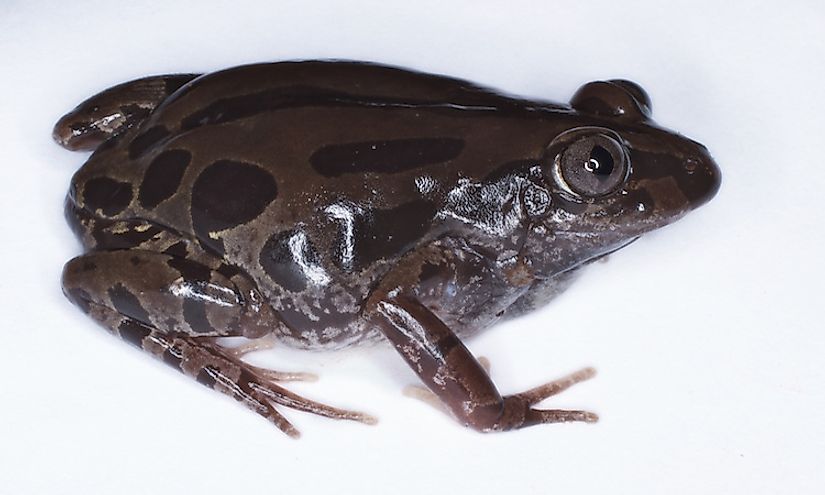Amphibians Of The Democratic Republic Of The Congo

- Caecilians are the only amphibians with tentacles on earth. Caecilians can sense vibrations with the organs they have in their heads.
- The Schmidt's Snouted Frog expresses digital reduction with four toes on the feet, doughnut or disk-shaped structures on the tip of the head and absence of the columella.
- The Shaba province toad is also known as the Amietophrynus fuliginatus.
The DR Congo is home to hundreds of species of frogs and toads, as well as three species of caecilians. The caecilians superficially resemble worms or snakes and lay eggs in soils. The eggs hatch into aquatic larva living in seepages of the soil or streams though some species lack the larva stage and instead jump to juveniles. The altitude ranges of the amphibians vary with some species like the M. Schmidti having extremely high altitudes. The habitats of these toads and frogs also tend to extend to other regions of Western Africa, and some species are also found in the East Africa. Below are some of the amphibians of DRC:
Congo Caecilian
Congo caecilian (Herpele squalostoma) lives in tropical moist lowlands forests, rural gardens, plantations and degraded former forests living underground. It is also found in sandy soils adjacent to watercourses. The species is likely oviparous where the parent provides parental care to the young ones that feed on their mother's skin. Sources indicate that the species also exists in protected areas in the Korup National Park of the neighboring Cameron. The species is native to the Western DRC mainland Equatorial Guinea, Nigeria, and Cameroun and the rest of West Africa. The species spread to East Africa is unknown.
Schmidt's Snouted Frog (a true toad)
Schmidti's snouted frog (Mertensophryne schmidti) is an actual toad. The frog is warty, plump with short legs. The toad expresses digital reduction with four toes on the feet, doughnut or disk-shaped structures on the tip of the head and absence of the columella.The natural habitats include the dry savanna, swamps, freshwater or intermittent freshwater marshes. The species so far has been found in the Pemba National Park in Southern DRC at altitudes of 960-1,300 m above sea levels. The frog’s high attitudes ranges limit herpetological work.
Shaba Province Toad
Amietophrynus fuliginatus commonly known as Shaba province toad is a toad belonging to the Bufonidae. In DRC they refer to it as the Shaba Province toad. The toad can so be found in Tanzania and Zambia. The toad lives in subtropical or tropical moist lowland forests, subtropical or tropical moist Montane forests. Habitat loss is the most significant threat facing the toad. The species exhibit free-living aquatic larval stage.
Senegal Running Frog
Senegal running frog (Kassina senegalensi) is a savanna-dwelling species found throughout Africa. It normally has an olive green background or gray with mid-dorsal black stripes and black spots or stripes. There are small disks at the tips of fingers and toe. In the rainy season, the K. Senegalensi is the noisiest animal in the African savannas and coastal lowlands and mostly it is the breeding/mating calls. The frog usually shuns the light of the full moon to avoid predation and other times it takes advantage of the light to forage or navigate. The frog especially the male species are known to be territorial and give off warning calls when other male species cross habitual boundaries. The frog can adapt to changes in habitat and can survive in agricultural areas. The frog preys on arthropods like termites, caterpillars, flies, ants, and spiders.The herald snake preys on Kassina. Tadpoles hatch within 5-6 days, develop slowly, and within 52-90 days the development is complete.
Threats Facing The Amphibians In The DRC
The primary threat is the loss of habitat caused by human activities like agriculture, livestock and pastures, and human settlements. Political instability in the country continues to threaten the existing habitats in their range.
In general, all amphibians have a similar life cycle. Water is crucial to their survival explaining why every habitat of these frogs and toads must have a water course. The water provides the aquatic environment needed to lay eggs, and the larval stage of some species takes place in water. The juveniles have the same body form as that of adults. Human encroachment is a significant threat facing amphibians, and there are also very few protective and conservative regions in the DRC.
Amphibians Of The Democratic Republic Of The Congo
| Amphibians of the Democratic Republic of the Congo | Scientific Name |
|---|---|
| Congo caecilian | Herpele squalostoma |
| Schmidt's Snouted Frog (a true toad) | Mertensophryne schmidti |
| Shaba Province toad | Amietophrynus fuliginatus |
| Senegal Running Frog | Kassina senegalensis |
| Ansorge's Ridged Frog | Ptychadena ansorgii |
| Rwandan caecilian | Boulengerula fischeri |
| Cameroon Clawed Frog | Silurana epitropicalis |
| De Witte's spiny reed frog | Afrixalus wittei |
| Bates' Tree Toad | Nectophryne batesii |
| Gaboon caecilian | Geotrypetes seraphini |







